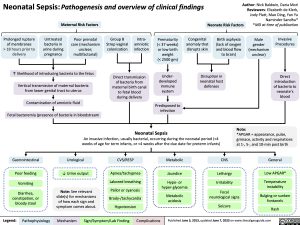Neonatal Sepsis: Pathogenesis and overview of clinical findings Maternal Risk Factors
Author: Nick Baldwin, Daria Mori Reviewers: Elizabeth de Klerk, Jody Platt, Mao Ding, Yan Yu Naminder Sandhu* *MD at time of publication
Neonate Risk Factors
Prolonged rupture of membranes
> 18 hours prior to delivery
Untreated
bacteria in urine during pregnancy
Poor prenatal care (mechanism unclear; multifactorial)
Group B Strep vaginal colonization
Intra- amniotic infection
Prematurity (< 37 weeks) or low birth weight
(< 2500 gm)
Under- developed immune system
Predisposed to infection
Congenital anomaly that disrupts skin
Birth asphyxia (lack of oxygen and blood flow to brain)
Male gender (mechanism unclear)
Invasive Procedures
Direct introduction of bacteria to neonate’s blood
↑ likelihood of introducing bacteria to the fetus
Vertical transmission of maternal bacteria from lower genital tract to uterus
Contamination of amniotic fluid
Fetal bacteremia (presence of bacteria in bloodstream
Direct transmission of bacteria from maternal birth canal to fetal blood during delivery
Disruption in neonatal host defenses
Neonatal Sepsis
An invasive infection, usually bacterial, occurring during the neonatal period (<4 weeks of age for term infants, or <4 weeks after the due date for preterm infants)
Note:
*APGAR = appearance, pulse, grimace, activity and respirations at 1-, 5-, and 10-min post birth
Gastrointestinal
Poor feeding
Vomiting
Diarrhea, constipation, or bloody stool
Urological ↓ Urine output
Note: See relevant slide(s) for mechanisms of how each sign and symptom comes about.
CVS/RESP
Apnea/tachypnea Labored breathing Pallor or cyanosis Brady-/tachycardia Hypotension
Metabolic
Jaundice
Hypo- or hyper-glycemia
Metabolic acidosis
CNS
Lethargy Irritability
Focal neurological signs
Seizure
General
Low APGAR*
Temperature instability
Bulging or sunken fontanels
Rash
Legend:
Pathophysiology
Mechanism
Sign/Symptom/Lab Finding
Complications
Published June 3, 2013, updated June 7, 2023 on www.thecalgaryguide.com
Foundations
Systems
Other Languages
Infectious Diseases Pediatric Neonatal Sepsis: Pathogenesis, and Overview of Clinical Findings Neonatal Sepsis

